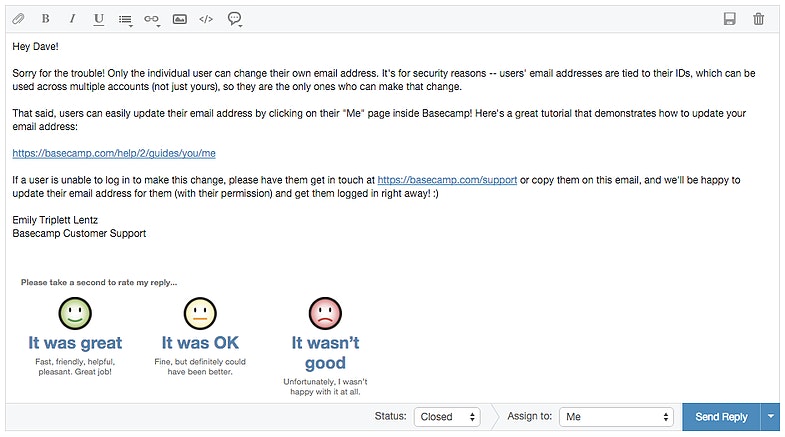Most customers can name at least one “missing” feature that would improve their experience with your product, but you can’t acquiesce to every feature request without your product turning into a bloated, unusable mess.
Support reps are all too familiar with the discomfort of telling customers no everything they want. We know better than to “apologize for the inconvenience,” but these conversations can still make us squirm.
How do you say no to customers? Here are seven ways the pros respond to feature requests so that customers are let down gently, and kept happy.
1. Ask for clarification
When customers are vague about why they’re upset (“Your update looks terrible. Make it more like it was before!”), they’re handing you the opportunity to request specifics (“Oh no, sorry to hear that! Would you mind telling me a little more about what you liked better about the old version?”). You may do something with that intel and you may not, but it’s a win either way: they walk away pleased someone is listening and flattered someone cares enough to want their opinion.
In addition, getting to the bottom of what people are trying to accomplish can help you solve their problem in a way they haven't considered. In a Support Ops hangout on saying “no” to customers, Carolyn Kopprasch, chief happiness officer at Buffer, recommends asking customers what they’re ultimately trying to achieve when they request a specific feature. “We can learn a lot from those kinds of conversations, if they’re willing to indulge us,” Kopprasch says.
With a little back-and-forth, you might discover that the customer asking for sub-projects really just needs a way to organize different teams sharing the same account, and hey, your product can do that.
2. Explain what’s going to happen next
At Eventbrite, customers will ask for niche features the company probably won’t entertain, says Vivian Chaves, a customer experience associate manager. For example, “It would be great if you had ‘cat birthday party’ as an option in your drop-down menu.”
Eventbrite support responds to those queries by letting the customer know that while there's no way to fulfill the request at this time, they’ll share it with the product team, who will review it and scope it in relation to other initiatives. They also share how approved requests are placed on their road map, followed by coding and testing to ensure a smooth integration with their existing product.
As a customer, it’s comforting to be assured that your request won’t disappear into the ether—there’s a process for handling requests, and you’re being taken seriously (even if you are the type of person who wants to throw a birthday party for your cat).
“If we truly aren't the right platform for them,” Chaves says, “we try to be open and honest at the start.”
Which brings us to the next point:
3. Be honest
It's tempting to tell a customer you’re going to share her idea with the development team when you have zero intention of doing so, or that you think his suggestion for yet another checkbox on the settings page is super-duper. But people can generally spot insincerity when they see it, and dishonesty can come back to bite you.
“We would rather say no and disappoint them,” Kopprasch says, “versus saying, ‘yeah maybe, let me check with my marketing team,’ and then in three months have them follow up and be like, ‘Aw man, I really thought you meant that.’ If we know the answer is going to be no, then we try to be honest upfront.”
4. Reframe the “no” using positive language
It’s possible to convey a clear “no” without ever saying the word. Instead of “No, we don’t have that,” try phrases like, “I can see how that would be useful, but I’m afraid we don’t have plans to add that functionality,” or “While there’s currently no way to do that, we appreciate you taking the time to let us know what you’re looking for—most of the improvements we make come from ideas and suggestions like yours, so thank you for reaching out!”
Done well, positive, honest language keeps the door open for future interactions, and the customer won’t feel as though it was a waste of time to get in touch.
5. Make the customer feel heard
Often, people just want to know someone on the other end is hearing them out. Small touches like using the customer’s name and phrases such as “I understand” or “I can see why you’d want that feature” go a long way. Thank people for letting you know what they’re looking for. Whatever their issue, it was important enough to take time out of their day to contact you. Acknowledge the effort and your gratitude for it.
Bonus tip: Reply quickly, but not too quickly. When you can modify your boilerplate language with the customer’s name and an acknowledgement of their specific issue in 30 seconds, it can make some people wonder if their email even got read. It’s okay to let non-urgent emails sit a few extra minutes.
6. Offer alternatives
You want to create happy customers, not marginally satisfied ones. When you don’t have what they’re looking for, you still have the opportunity to generate goodwill by pointing them toward a workaround or even a competitor. Zappos, for example, refers customers elsewhere when they don’t have an item in stock. The resulting long-term loyalty and word-of-mouth advertising outweigh any short-term loss.
7. Explain the reasoning behind the current design
When people understand the “why,” they’re more likely to be forgiving. During my time on the support team at Basecamp, for instance, we’d sometimes receive emails from customers who wanted to change another user’s email address within the app. My replies in those conversations looked something like this:

…which would often lead to positive customer feedback like this:
She gave me an answer that I really didn’t want to hear, but gave me a work-around that was elegant enough that I forgot to be sad I didn’t get what I asked for. She was empathetic. Good customer service and technical knowledge.
The next best thing to giving customers what they want is making them feel as though their ideas are taken seriously.
When combined, these techniques make your “no” sound (almost) as good a “yes”—and you’ll strengthen both your personal relationships with customers as well as your reputation as a company who cares.








